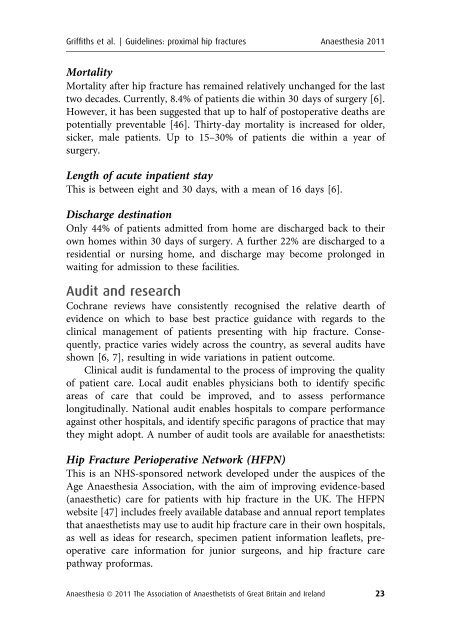Management of Proximal Femoral Fractures 2011 - aagbi
Management of Proximal Femoral Fractures 2011 - aagbi
Management of Proximal Femoral Fractures 2011 - aagbi
You also want an ePaper? Increase the reach of your titles
YUMPU automatically turns print PDFs into web optimized ePapers that Google loves.
Griffiths et al. | Guidelines: proximal hip fractures Anaesthesia <strong>2011</strong>MortalityMortality after hip fracture has remained relatively unchanged for the lasttwo decades. Currently, 8.4% <strong>of</strong> patients die within 30 days <strong>of</strong> surgery [6].However, it has been suggested that up to half <strong>of</strong> postoperative deaths arepotentially preventable [46]. Thirty-day mortality is increased for older,sicker, male patients. Up to 15–30% <strong>of</strong> patients die within a year <strong>of</strong>surgery.Length <strong>of</strong> acute inpatient stayThis is between eight and 30 days, with a mean <strong>of</strong> 16 days [6].Discharge destinationOnly 44% <strong>of</strong> patients admitted from home are discharged back to theirown homes within 30 days <strong>of</strong> surgery. A further 22% are discharged to aresidential or nursing home, and discharge may become prolonged inwaiting for admission to these facilities.Audit and researchCochrane reviews have consistently recognised the relative dearth <strong>of</strong>evidence on which to base best practice guidance with regards to theclinical management <strong>of</strong> patients presenting with hip fracture. Consequently,practice varies widely across the country, as several audits haveshown [6, 7], resulting in wide variations in patient outcome.Clinical audit is fundamental to the process <strong>of</strong> improving the quality<strong>of</strong> patient care. Local audit enables physicians both to identify specificareas <strong>of</strong> care that could be improved, and to assess performancelongitudinally. National audit enables hospitals to compare performanceagainst other hospitals, and identify specific paragons <strong>of</strong> practice that maythey might adopt. A number <strong>of</strong> audit tools are available for anaesthetists:Hip Fracture Perioperative Network (HFPN)This is an NHS-sponsored network developed under the auspices <strong>of</strong> theAge Anaesthesia Association, with the aim <strong>of</strong> improving evidence-based(anaesthetic) care for patients with hip fracture in the UK. The HFPNwebsite [47] includes freely available database and annual report templatesthat anaesthetists may use to audit hip fracture care in their own hospitals,as well as ideas for research, specimen patient information leaflets, preoperativecare information for junior surgeons, and hip fracture carepathway pr<strong>of</strong>ormas.Anaesthesia ª <strong>2011</strong> The Association <strong>of</strong> Anaesthetists <strong>of</strong> Great Britain and Ireland 23
















